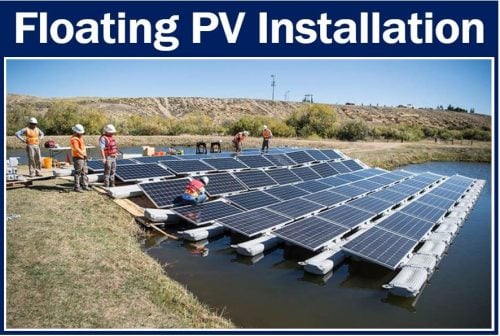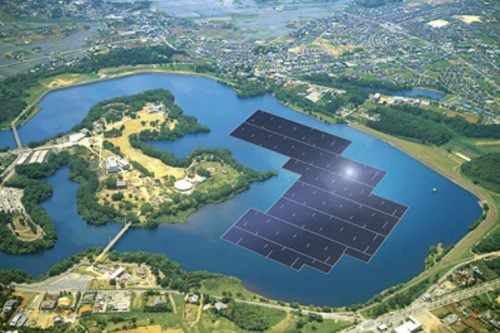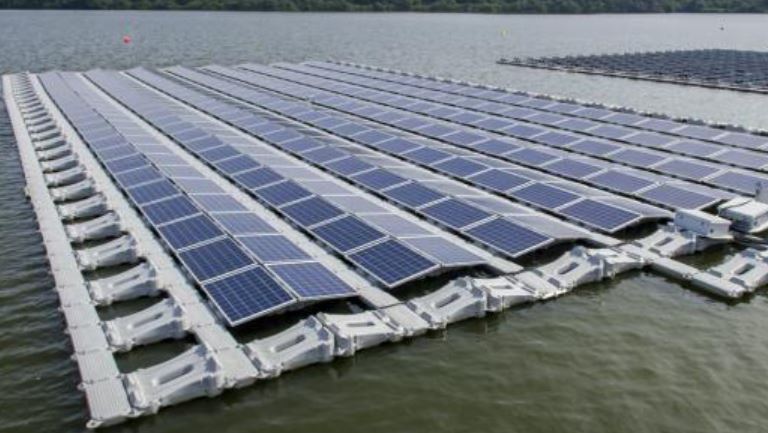By installing floating PV systems on over 24,000 artificial reservoirs, the US could generate approximately 10% of its annual electricity generation. This is what researchers at the NREL wrote in the journal Environmental Science & Technology (citation below). NREL stands for the National Renewable Energy Laboratory.
The authors of the article were Robert S. Spencer, Jordan Macknick, Alexandra Aznar, Adam Warren, and Matthew O. Reese.
The letters PV stand for photovoltaics. We use the letters PV for both the singular and plural forms. Photovoltaics is the conversion of light into electricity using semiconducting materials. These materials exhibit the photovoltaic effect.
This is the first time anybody has put forward the idea of using floating PV to generate electricity in the US.
The US was the first country to demonstrate floating PV panels. The first installation occurred a decade ago on pontoons on an irrigation pond in the Napa Valley in California.
However, the idea did not receive nationwide acceptance. Since the turn of the century, America has focused on the installation of large-scale, ground-mounted solar panels.
In December 2017, for example, the country only had seven floating PV sites. Other countries, on the other hand, have been keener to adopt floating PV systems. Japan, for example, has 56 of the world’s 70 largest floating PV installations.

Solar energy
Floating PV systems are part of the solar energy sector. Solar energy refers to capturing the Sun’s energy and then converting it into electricity.
We use that electricity to light up our businesses, homes, streets, and also to power our machines. The term ‘solar power‘ has the same meaning.
Floating PV systems a ‘niche’ in USA
Lead investigator of the project, Jordan Macknick, and the lead energy-water-land analyst for NREL, said:
“In the United States, it’s been a niche application; where in other places, it’s really been a necessity. Floating PV: Assessing the Technical Potential of Photovoltaic Systems on Man-Made Water Bodies in the Continental U.S.”
“We’re expecting it to take off in the United States, especially in areas that are land-constrained and where there’s a major conflict between solar encroaching on farmland.”
The authors estimate that America could save approximately 2.1 million hectares by installing floating PV systems on bodies of water rather than on the ground. By using floating PV systems, there are also two added benefits – less algae growth and water evaporation.
Lead author, Robert Spencer, said that in some cases the benefits could be greater than those mentioned in the paper. The researchers used “strict assumptions that would give us a very conservative estimate of the total potential generation and benefits,” Spencer explained.

Floating PV next to hydroelectric facilities
In their study, the researchers also found that floating PV systems next to hydroelectricity facilities yielded greater energy output. This was because of the existing transmission infrastructure.
Adam Warren, Director of NREL’s Integrated Applications Center, said:
“Floating solar is a new industry enabled by the rapid drop in the price of solar PV modules. The cost of acquiring and developing land is becoming a larger part of the cost of a solar project.”
“In some places, like islands, the price of land is quite high, and we are seeing a rapid adoption of floating solar.”
Citation
“Floating Photovoltaic Systems: Assessing the Technical Potential of Photovoltaic Systems on Man-Made Water Bodies in the Continental United States,” Robert S. Spencer, Jordan Macknick, Alexandra Aznar, Adam Warren, and Matthew O. Reese. Environmental Science and Technology. Article ASAP. DOI: DOI: 10.1021/acs.est.8b04735.
Video – Floating PV systems in the USA
This NREL video explains how floating solar PV systems could influence the changing energy landscape in the US.

